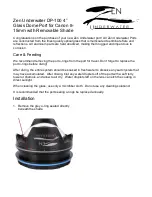
Maintenance
Hauser
23
Generally, the following applies:
• The membrane cap must be replaced if:
– It is damaged.
– It is stretched. This makes the produced sensor currents too small.
• Changing the electrolyte is mandatory if the membrane body is detached.
• Sensors operated close to the zero point consume hardly any chemical electrolyte. The electrolyte
does not have to be replaced for a long period.
• Sensors operated at high partial oxygen pressures (> 100 hPa) consume a significant amount of
electrolyte. The electrolyte has to be replaced frequently.
Removing the old membrane body
1.
Remove the sensor from the medium.
2.
Clean the outside of the sensor.
3.
Hold the sensor vertically and unscrew the shaft sleeve.
The membrane body is either in the shaft sleeve or is still on the glass portion with the anode and
cathode.
4.
Remove the membrane body.
To do so, use a suitable tool or carefully press it out of the shaft sleeve from the outside.
5.
Decide:
a. Do you want to replace the membrane body and not use it again?
►
Dispose of the electrolyte and the old membrane body.
b. Do you want to replace the electrolyte only and not replace the membrane body?
►
Drain the membrane body and flush with potable water.
►
Continue as for the new membrane body.
Installing the new membrane body
1.
Fill fresh electrolyte from the supply bottle into a new membrane body.
2.
Remove all air bubbles from the electrolyte by tapping the side of the membrane body (using a pen
or pencil, for example).
3.
Hold the sensor vertically and carefully push the membrane body, filled with electrolyte, on the
glass portion.
4.
Carefully screw on the shaft sleeve as far as it will go.
After replacing the membrane cap, the sensor must be repolarized and
recalibrated. Then insert the sensor into the medium and check that no alarm is displayed on the
transmitter.














































